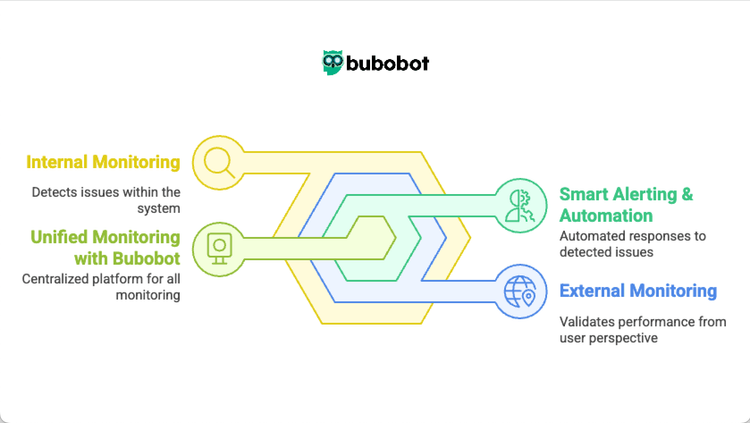External vs Internal Monitoring: Which is Better for Uptime?

1. Introduction: The Role of Uptime & Monitoring
Picture this: Your production system is running perfectly—or so you think.
Your internal uptime monitoring dashboards show all green, yet customers are flooding your support channels with access issues.
Or the reverse: external uptime monitoring shows your API is responsive, but internally, your systems are reaching critical thresholds. These scenarios highlight a crucial reality in modern infrastructure monitoring: blind spots can exist even in seemingly comprehensive monitoring setups.
For DevOps teams and IT administrators managing critical infrastructure, the challenge isn't just about monitoring uptime—it's about having the right monitoring strategy that provides complete visibility into your system's health.
2. Internal vs External Monitoring: Key Differences & Complementary Roles
Instead of treating internal and external monitoring separately, let's compare them directly for clarity:
| Aspect | Internal Uptime Monitoring | External Uptime Monitoring |
|---|---|---|
| Definition | Monitors internal system health, logs, and performance. | Monitors system availability & performance from external locations. |
| Key Metrics | CPU, memory, disk usage, internal service response times. | Website uptime, API availability, latency, global response times. |
| What It Detects | Application performance issues, infrastructure failures. | User experience issues, ISP/network failures. |
| Advantages | ✅ Full control & security. | |
| ✅ Can detect root causes internally. | ✅ Detects real-world downtime. | |
| ✅ Monitors from multiple locations. | ||
| Limitations | ❌ Cannot detect external failures (ISP, DNS, CDN, etc.). | ❌ Relies on third-party tools. |
| ❌ Cannot diagnose internal failures. | ||
| Example Tools | Prometheus, Datadog APM, Zabbix. | UptimeRobot, Pingdom, Bubobot 🚀. |
| Pro TIPS | 💡 Monitor your monitoring! Set up cross-server agent health checks to prevent blind spots from failed monitoring agents. | 💡 Choose monitoring locations strategically! Match your monitoring nodes to your actual user base and peak business hours. |
📌 Key Takeaway: Neither internal nor external monitoring alone provides full coverage. Both must work together to ensure high uptime.
3. How to Maximize Uptime with a Hybrid Uptime Monitoring Solution

Let me share a story. Last month, a client's monitoring system showed all green internally - perfect CPU usage, healthy memory levels, everything looking great. But their customers couldn't access the website. Why? A DNS issue that only external monitoring could catch. That's exactly why you need both types of monitoring working together.
Here's how to make it happen:
Early Detection Through Internal Monitoring
Ever had your application slow to a request because one server was running overloaded? That's why you track resource usage patterns. One of our clients caught a memory leak before it could crash their production system just by watching these trends.
Start with these basics:
- Set up resource monitoring (CPU, memory, disk) with reasonable thresholds.
- Keep an eye on those application logs - they'll tell you when something's wrong before users notice
- Watch your database performance, slow queries have a nasty habit of snowballing into bigger problems
Real-World Validation with External Monitoring
Sometimes, your internal monitoring might say everything's fine, but if users can't access your service, you've got a problem.
A practical approach:
- Check your system's availability from different locations. Users access your service from everywhere, so should you
- Don't forget about DNS and SSL certificates. I've seen entire systems go down because someone forgot to renew a certificate
- Test your critical user paths regularly. If your checkout process breaks, you want to know before your customers do
- Monitor those API response times - because slow is the new down
Smart Alerting & Automation
Now, you've got all these monitoring tools, but getting bombarded with alerts isn't helpful. You need smart alerts that actually mean something.
Here's what works:
- Set up an escalation workflow that makes sense. Start with internal checks, confirm with external monitoring, then alert the right people
- Use AI to cut through the noise. Let's be honest - nobody wants to wake up at 3 AM for a false alarm
- Automate the obvious stuff. If you know rebooting a service fixes an issue, why not automate it?
- Create different alert channels based on severity. Not everything needs a midnight phone call
Unified Monitoring with Bubobot
This is where Bubobot makes your life easier. Instead of juggling multiple tools and dashboards, you get everything in one place.
What you'll love:
- One dashboard to rule them all - see both internal and external monitoring in a single view
- Smart alerts that actually help you solve problems, not just point them out
- Heartbeat monitoring that catches issues before they become problems
- AI-powered insights that help you prevent issues, not just react to them
And here's a pro tip: Start with monitoring your most critical services first. You don't need to monitor everything right away. Focus on what matters most to your business and expand from there.
4. Conclusion
The question isn't whether to choose internal or external monitoring - you need both. They complement each other perfectly, giving you a complete view of your system's health and availability.
Remember: Internal monitoring helps you understand what's happening inside your system, while external monitoring tells you how users are experiencing it. Together, they form a comprehensive monitoring strategy that helps maintain high uptime and quick issue resolution.
Ready to strengthen your monitoring strategy? Start with Bubobot's comprehensive monitoring solution (Hybrid Uptime Monitoring Solution) that combines the best of both worlds. Try it free today and see the difference proper monitoring can make for your system's uptime.
#MonitoringTools #InternalVsExternal #ITManagement